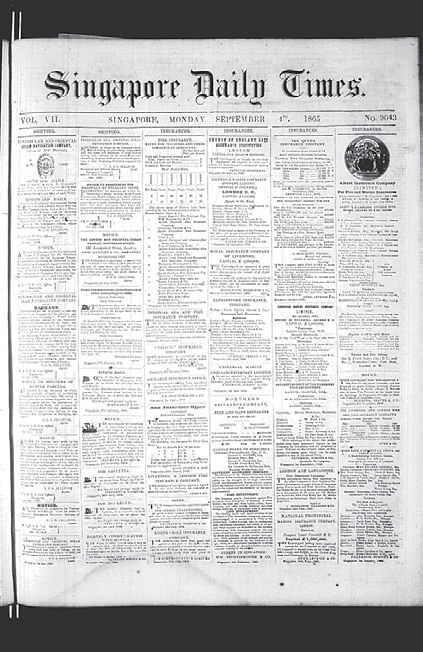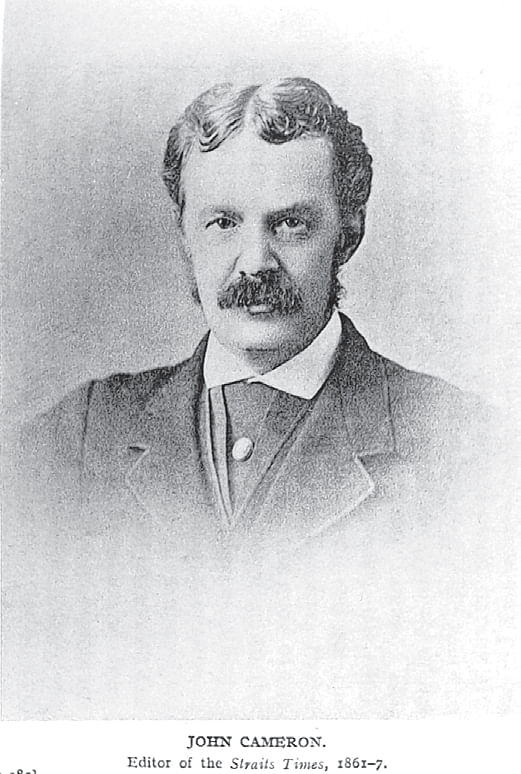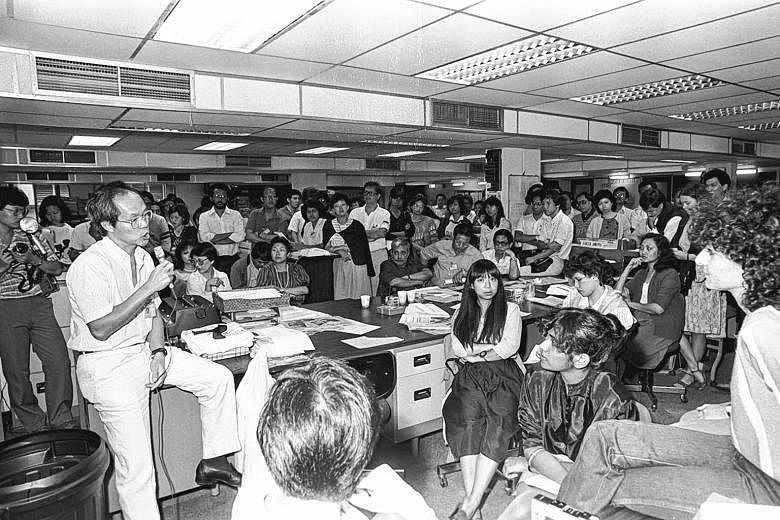In the early 20th century, as Singapore was transformed from a makeshift settlement with an uncertain future into a bustling cosmopolitan city where East and West could profitably tryst, The Straits Times found its own sweet spot.
The newspaper had come to regard itself as Singapore's paper of record and hungered to become the leading newspaper of the region. At first, the answer seemed to lie in becoming the "Thunderer of the East", in the way The Times of London, with its imperious editorials, was the original "Thunderer".
The Straits Times earned that nickname under the passionate editorship of Alexander William Still, an experienced British editor hired in 1908. Malaya was then at the height of the rubber boom and Still took great pains to study the economics of the region's most valuable commodity.
His fears that a bust was round the corner proved right and he pushed the government and the industry to rally around policies that would combat the slump. When World War I broke out in 1914, he led The Straits Times in efforts to raise money and recruit volunteers for forces overseas.
-
Big challenges, fresh ideas
-
MODERN-DAY EDITORS
 7 Peter Lim Heng Loong: He introduced the "What it should have been" column, which publicly acknowledged and corrected errors in the newspaper. He is also credited with popularising the use of graphics in story-telling. Mr Lim, who became editor-in chief in 1978 at age 40, introduced the annual performance appraisal system for staff as well as in-house and overseas training opportunities.
7 Peter Lim Heng Loong: He introduced the "What it should have been" column, which publicly acknowledged and corrected errors in the newspaper. He is also credited with popularising the use of graphics in story-telling. Mr Lim, who became editor-in chief in 1978 at age 40, introduced the annual performance appraisal system for staff as well as in-house and overseas training opportunities. 8 Cheong Yip Seng: He expanded the coverage of national politics, setting up a political desk in the early 1980s. His belief that "easy reading is damn hard writing" changed journalistic writing in the newspaper. Appointed editor in 1979, at age 35, he became editor-in-chief in 1987. He implemented an editorial policy that affirmed the need to foster national identity and a Singaporean point of view in reporting stories.
8 Cheong Yip Seng: He expanded the coverage of national politics, setting up a political desk in the early 1980s. His belief that "easy reading is damn hard writing" changed journalistic writing in the newspaper. Appointed editor in 1979, at age 35, he became editor-in-chief in 1987. He implemented an editorial policy that affirmed the need to foster national identity and a Singaporean point of view in reporting stories. 9 Leslie Fong: Appointed editor in 1987 at age 37, he ended the practice of publishing anonymous letters from readers. He also banned smoking in the newsroom, making The Straits Times among the first newspapers in the world to do so. His term saw the launch of several initiatives like The Straits Times website and The Straits Times School Pocket Money Fund to help poor children with school expenses.
9 Leslie Fong: Appointed editor in 1987 at age 37, he ended the practice of publishing anonymous letters from readers. He also banned smoking in the newsroom, making The Straits Times among the first newspapers in the world to do so. His term saw the launch of several initiatives like The Straits Times website and The Straits Times School Pocket Money Fund to help poor children with school expenses. 10 Han Fook Kwang: He was named The Straits Times' editor in 2002 at age 49. A former senior public servant who joined the paper in 1989, he later became its Political Editor. He introduced its weekly Insight section of political features and commentaries. He is the co-author of two books: Lee Kuan Yew: The Man And His Ideas (1997) and Lee Kuan Yew: Hard Truths To Keep Singapore Going (2011), and led the team which worked on Mr Lee's memoirs.
10 Han Fook Kwang: He was named The Straits Times' editor in 2002 at age 49. A former senior public servant who joined the paper in 1989, he later became its Political Editor. He introduced its weekly Insight section of political features and commentaries. He is the co-author of two books: Lee Kuan Yew: The Man And His Ideas (1997) and Lee Kuan Yew: Hard Truths To Keep Singapore Going (2011), and led the team which worked on Mr Lee's memoirs. 11 Patrick Daniel: When Mr Daniel took charge as editor-in-chief in 2007 at age 52, print media across the world was facing huge challenges from online media. Apart from leading The Straits Times' multimedia strategies, he streamlined newsroom processes and restructured the newspaper division into a media group comprising both print and digital operations, as well as business adjacencies such as radio, book publishing and financial data. A former editor of The Business Times, he also oversees the group's Malay and Tamil newspapers.
11 Patrick Daniel: When Mr Daniel took charge as editor-in-chief in 2007 at age 52, print media across the world was facing huge challenges from online media. Apart from leading The Straits Times' multimedia strategies, he streamlined newsroom processes and restructured the newspaper division into a media group comprising both print and digital operations, as well as business adjacencies such as radio, book publishing and financial data. A former editor of The Business Times, he also oversees the group's Malay and Tamil newspapers. 12 Warren Fernandez: Since becoming editor in 2012 at age 45, Mr<TH>Fernandez has turned The Straits Times' newsroom into a 24/7, multimedia operation, ready for the digital age of smartphones, tablets and social media. To deepen the paper's ties with the community, he organised forums on issues like education and foreign affairs, as well as concerts and the ST Run. He led the first ST redesign across print, website and mobile products.
12 Warren Fernandez: Since becoming editor in 2012 at age 45, Mr<TH>Fernandez has turned The Straits Times' newsroom into a 24/7, multimedia operation, ready for the digital age of smartphones, tablets and social media. To deepen the paper's ties with the community, he organised forums on issues like education and foreign affairs, as well as concerts and the ST Run. He led the first ST redesign across print, website and mobile products.
Still's opinion came to be valued, and The Straits Times sold on the strength of his name. Billboards posted around town advertised his editorials which were hotly debated in clubs and over dinner tables. Sometimes, his outspoken comments tangled The Straits Times in commercial libel suits which the newspaper either lost or settled out of court.
One estimate was that these suits cost the newspaper about $30,000. But they also boosted circulation, advertising revenue and the paper's reputation for forthright comment.
When the Great Depression of 1930s brought the rubber-and-tin exporting economy to a near-standstill, The Straits Times kept its head while others were losing theirs, further cementing its credibility.
It urged companies to fight defeatism - to extend, not shrink, their activities. It called on the government to spend its surpluses, resist cutting public expenditure and avoid retrenchments to speed up recovery. The editor, George Seabridge, a veteran from London's Fleet Street, Paris, Berlin and Calcutta, decided The Straits Times needed to set a bold personal example of expanding and spending its way out of the slump. Ignoring gloomy predictions that Singapore would go back to being a swamp and a fishing village, Seabridge chose to think big. He bought a fleet of Morris Minor vans to deliver the paper upcountry, ordered state-of-the-art printing machinery and drew up plans to construct a new office. The move kept morale high and the investment in modernisation paid off handsomely for years to come.
MASS APPEAL
The period of deep economic distress was also one of frenetic innovation. More pages, more pictures and cartoons, a section for women, one for servicemen, a morning tabloid, a Sunday newspaper, a bureau in Kuala Lumpur, a paper route in Penang, football sweepstakes - The Straits Times tried them all and hardly any move went amiss.
Singapore's growing population underwrote the experimentation - more European families were arriving, including servicemen and technicians to build the British naval base, and the numbers of English-educated Asians were growing as well, adding to the newspaper's readership. By 1933, The Straits Times had even worn down its old rival, the Singapore Free Press, and made it its own.
The one competitor on the horizon was the Malaya Tribune, which billed itself as the true son of the soil and the newspaper of Singapore's Asian communities. With one masterstroke in 1938, The Straits Times blasted ahead by halving its cover price to 5 cents. Its circulation almost doubled to 15,000 within a year, far outstripping that of the Tribune.
Now, The Straits Times appeared to have it all - articles with mass appeal, weighty editorials, a friendly price, a modern printing press and a distribution network that stretched to the Malay peninsula, even using Wearnes Air Services to deliver copies to Kuala Lumpur. Can a newspaper be high-brow and popular at the same time? The Straits Times could confidently say: "Yes."
OUR STRAITS TIMES STORY continued on...
TRANSFER CAMPAIGN
1853
The Straits Times becomes one of the main supporters of a 10-year campaign to transfer the Straits Settlements to direct colonial rule in view of its fraying connection with the East India Company and growing links to Britain and the rest of Europe. The transfer takes places in 1867.

1858
NEW NAME
The paper becomes an afternoon daily, with a new name: Singapore Daily Times. A weekly Straits Times is launched for overseas distribution.

1869
A FIRE
A fire destroys The Straits Times premises and plant, forcing editor John Cameron into bankruptcy. What remains fetches $40 at an auction. Yet the edition comes out on schedule. Aided by a friendly printer, it comes out the day after the fire, lambasting the inefficient fire brigade in an editorial.



